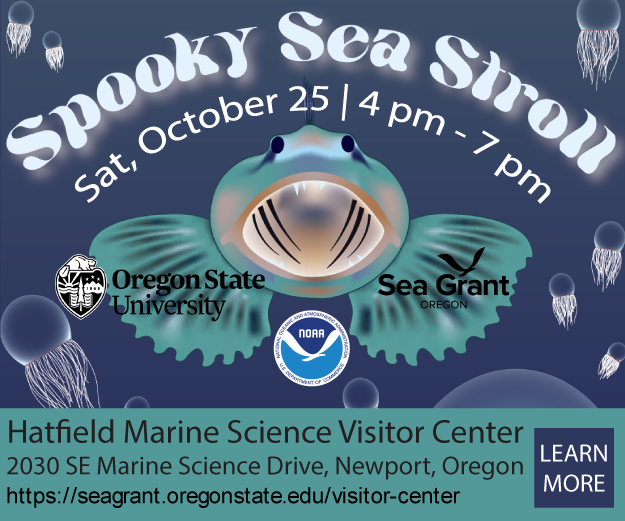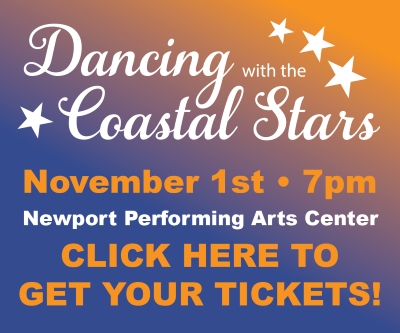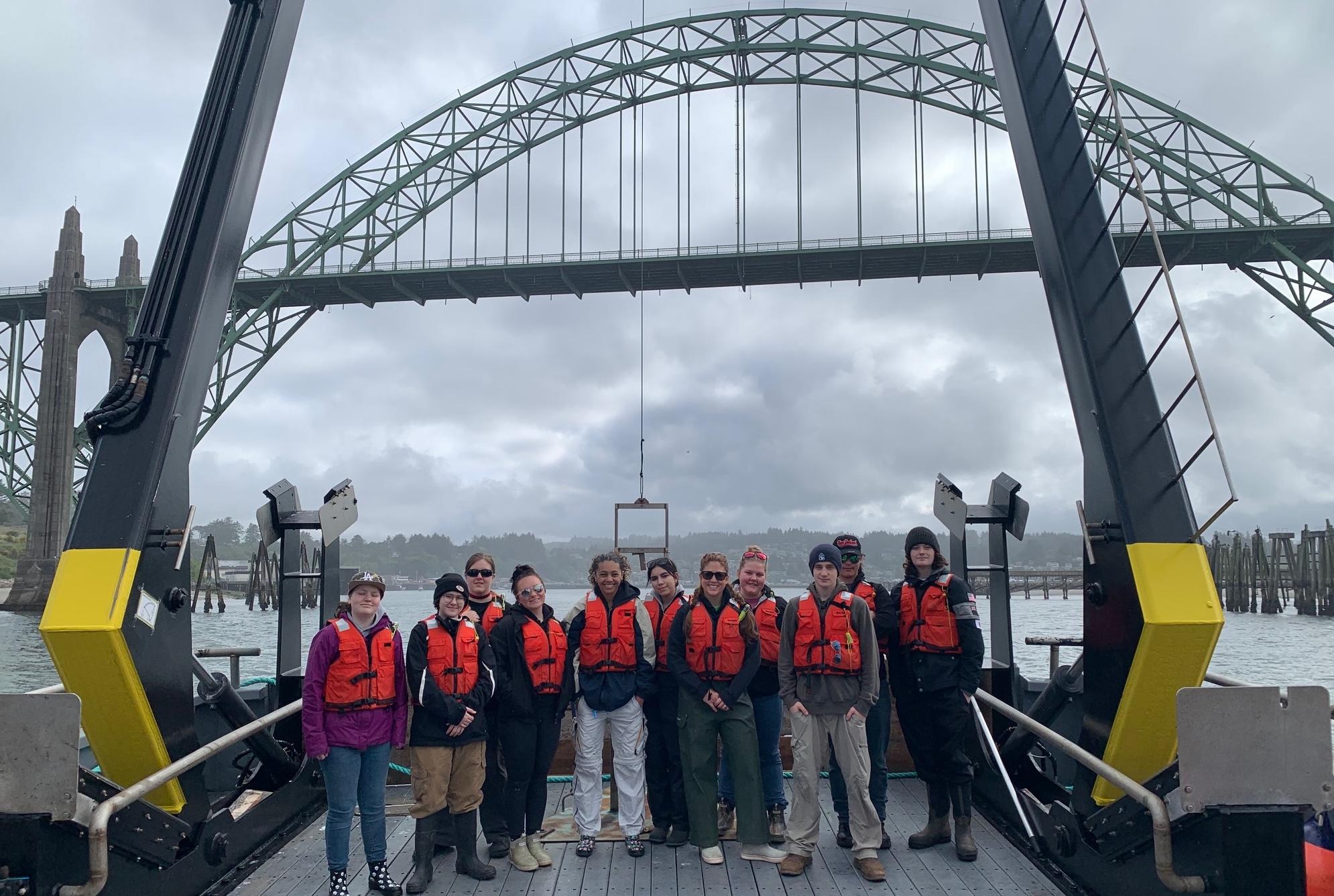
By GARRET JAROS/Lincoln Chronicle
Rolling seas with tightly-packed peaks rock the research vessel Pacific Storm relentlessly – the bow alternately rising high before plunging into the next trough – as the 84-foot former trawler steams toward Stonewall Bank in search of humpback whales.
The conditions do not phase the salt-soaked crew.
But after 1½ hours, the youthful enthusiasm that initially drew the majority of the 10 Waldport High School biology students aboard to seek out the crow’s nest – the highest and most motion-prone perch on the ship – has turned to nausea for some.

“We call the crow’s nest the dance floor,” Kevin Cool, chief mate and alternate captain told the students during the pre-trip safety briefing and ship tour before leaving the dock in Newport. “Stay on the back deck if you feel sick, not in the wheelhouse or the lab. That tends to cause a chain reaction.”
Warnings about seasickness and ingesting medicines to combat seasickness along with where to get sick – overboard or on the back deck if need be – “it happens all the time and we have a hose” – were ubiquitous and peppered throughout the morning’s dockside briefing.
The ocean-going field trip last week aboard the Oregon State University research vessel is made possible through Oregon Sea Grant’s STEM (Science, Technology, Engineering, Mathematics) at Sea program, which provides hands-on research experiences to inspire students to pursue marine-related careers.
During the excursions, OSU postdoctoral, research assistants and graduate students teach students how to use scientific equipment to conduct research that ranges from studying creatures found in seafloor sediment to get baseline data at wave energy test sites, measuring ocean temperatures and salinity, to counting and identifying individual humpback whales by the unique patterns (akin to a human fingerprint) on their tail flukes.
Tracy Crews, a marine biologist who organizes the trips for high school and college educators and students, is the associate director for Sea Grant’s marine education program at Hatfield Marine Science Center. She also helped to launch the program in 2016.

Crews, who acts as “party chief” on all the trips believes “kids aspire to what they know,” and wants to give them an opportunity to connect with researchers while getting out on the ocean to help them realize the career opportunities.
“And then also I think that we are suffering generally from a lack of trust in science and so I think that allowing the opportunity for students to connect with real researchers and see how science and data are collected will hopefully help to improve that,” Crews said.
“We really want to build data literacy and science literacy and even students that aren’t going to go into careers in science, that they appreciate and understand why science is important in our lives and to our environment and protecting it.”
Crews makes her way around the ship educating students about signs that whales may be in the area, like large flocks of birds which indicate shrimp-like crustaceans called krill and small fish may be near the surface. Both gray and humpback whales filter-feed by swallowing the small prey in massive gulps then straining them from the ocean water through their baleen plates, which act like a sieve.
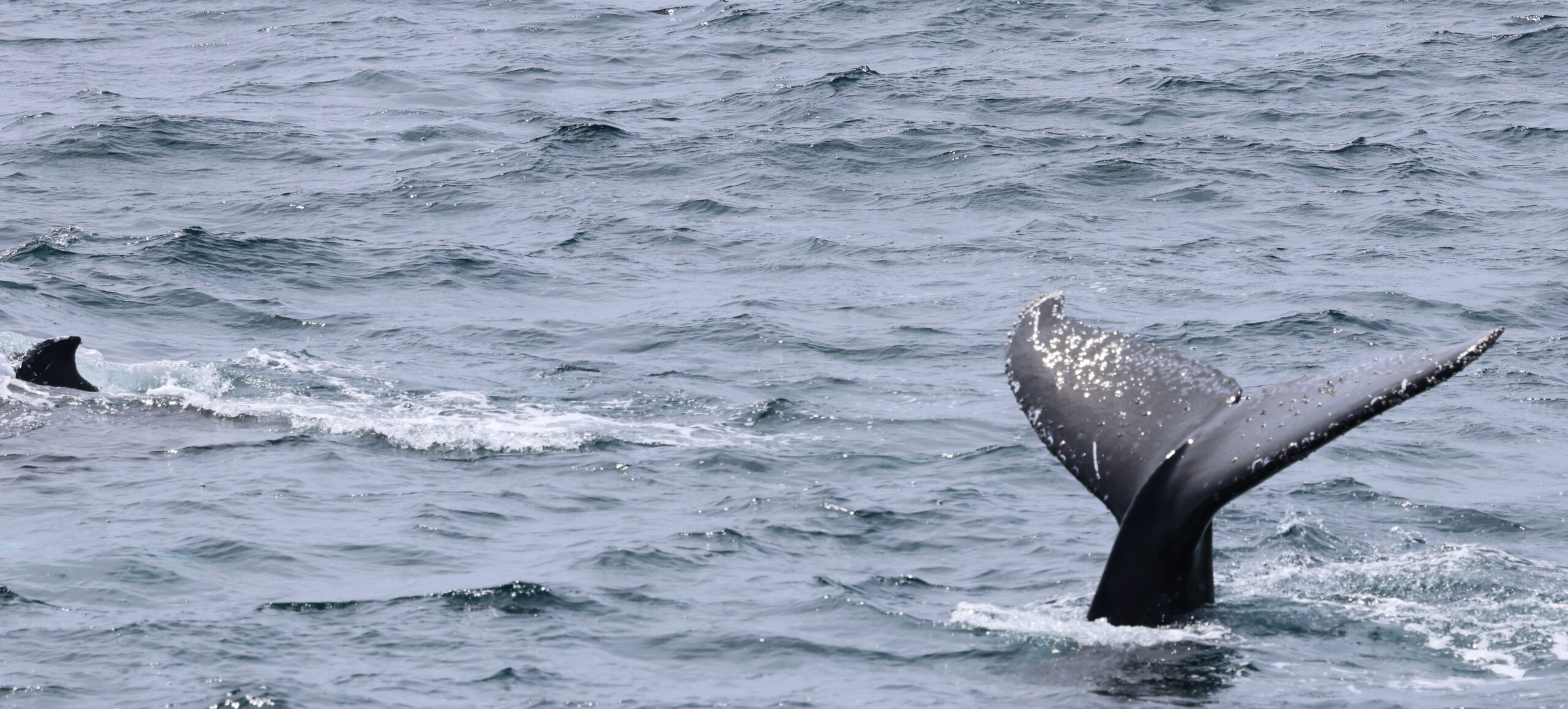
The whale search
The Waldport High students have been diligently scanning the horizons for the telltale humped backs and spouts – the big puffs of air released by the whales when they surface – but to no avail as the Pacific Storm bucks and bobs its way at seven knots (just over seven mph) to Stonewall Bank some 21 miles due west of Newport.
The two OSU researchers onboard, who sit in the crow’s nest as they scan the sea with binoculars, have chosen Stonewall Bank because of its abundance of food and because of a recent sighting there of a humpback mother and its calf.
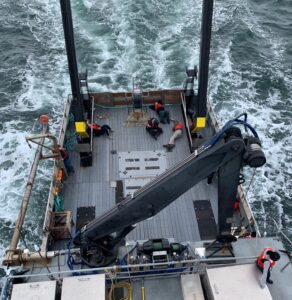
But the bank is still more than an hour away when the body count on the back deck begins to pile up. Some students are flat on their backs, others hold their heads in their hands while still others cling to anything solid to stay on their feet as they make their way to the railing to feed the fish.
“Research at sea is not for the faint of heart,” Crews says. “Seasickness is definitely something that plagues people. “There’s an awful lot of marine scientists who go all the way through undergraduate and graduate school and don’t realize that they get seasick.”
That being said, she adds, there are a lot of jobs on shore that help support and are connected to marine science so that you don’t have to go to sea.
The call of a humpback whale breaching in the distance comes down from the crow’s nest to the wheelhouse just a few miles shy of Stonewall. Cool turns the ship 44 degrees to starboard in pursuit.
“The thing about this is that it’s kind of a crapshoot,” Cool says. “You can’t count on them being in the same place you saw them before.”
But it isn’t long before someone calls out another sighting. And then another. Waldport high and middle school biology teacher Alissa Rickborn, sums up the scene 45 minutes later — “There are whales everywhere out here!”
The Pacific Storm has landed on a good-sized group of humpbacks who are busy feeding, some of them passing close to the ship. By law the vessel cannot approach too close to the whales so as not to disturb their activities. Cool positions the ship behind the whales in order to give the researchers a better chance of capturing a picture of their flukes that will later be loaded into a database.
OSU postdoctoral researcher Clara Bird uses a telephoto lens to capture images while both she and her research partner Celest Sorrentino also check the whales for scarring caused by getting tangled in fishing gear.
The survey data the researchers and students gather on the trip will be added to previous data to help not only identify individuals, but also to estimate overall numbers and to map where they travel and where they might travel in the future. That in turn can help avoid potential entanglements with crab pot lines, fish nets and collisions with ships, just a few of the potential hazards faced by the whales.
Humpbacks are the sixth largest whale in the world and reach lengths of nearly 60 feet and weigh more than 50 tons. They are one of the longest migrating mammals on the planet, some traveling as far as 5,000 miles as they migrate between colder waters rich with food to tropical waters where they give birth.
At least four humpback populations occur in the North Pacific but there are populations worldwide. Unlike gray whales, Humpback’s tend to stay farther offshore as they move past the Oregon coast.

A taste of science
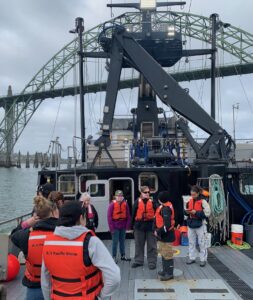
The Waldport students, who represent the full complement of Rickborn’s high school biology class, said they appreciated the opportunity to learn alongside the researchers on the Pacific Storm.
“I think it’s a really awesome experience and it’s been extremely fun so far,” said junior Eraa Collins. “It’s only the second time I’ve been out on the ocean. It’s very exciting.”
Collins has always been interested in marine biology and biology in general, she said. “And being able to actually see and experience what people go through does interest me quite a bit. I’m not sure what I’ll do career-wise but science is on the list. It’s interested me since I was a child.”
Sophomore Levi York, who spent much of the trip in the crow’s nest without ever feeling nauseous, said she plans to be an artist but has a love for biology.
“It is a very interesting topic to me,” York said. “I enjoy that I can apply it to my real life. There’s a lot of classes that I take that I don’t really know why I’m learning what I’m learning, but with biology I really feel like I understand what I’m learning about.”
She added that like Collins it is her first time going so far out to see and that “I am enjoying it a lot.”
Junior Payton Abele says she is exactly where she wants to be as she someday hopes to be a marine biologist and plans to study it at the University of Washington.
“They have a great marine biology program,” Abele said. “I went there for my birthday and toured the school and I just had that feeling when you know something is right. And that’s the feeling I have.
“I like lots of marine mammals not just whales,” she said. “But they are very cool creatures. And just being able to observe them today was a great opportunity.”
Rickborn, who has a doctorate in Zoology, said she wanted her students to have the opportunity to get some “authentic scientific research” while also exploring possible career opportunities.
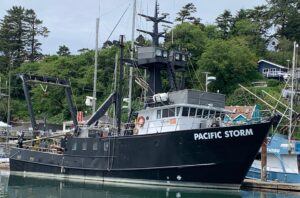
“But more importantly, I think just getting outside and experiencing a part of the coast that a lot of our students have probably never seen,” Rickborn said. “Most of them have not been out on a boat or never this far out to sea. So just getting to experience more of where they live is really important.”
When the boat finally arrives back at port, nearly nine hours after setting out, Bird sums up the whale count for non-scientists.
“We were surrounded,” Bird said. “There were lots on the horizon but up close I’d say probably 10 to 15. And she added a thanks to Oregon Sea Grant.
“They provide the opportunity for us as scientists to not just collect great data but also to share our work with high schoolers, to help impart this knowledge,” she said. “It’s really cool.”
- Garret Jaros covers the communities of Yachats, Waldport, south Lincoln County and natural resources issues for the Lincoln Chronicle, formerly YachatsNews, and can be reached at GJaros@YachatsNews.com





